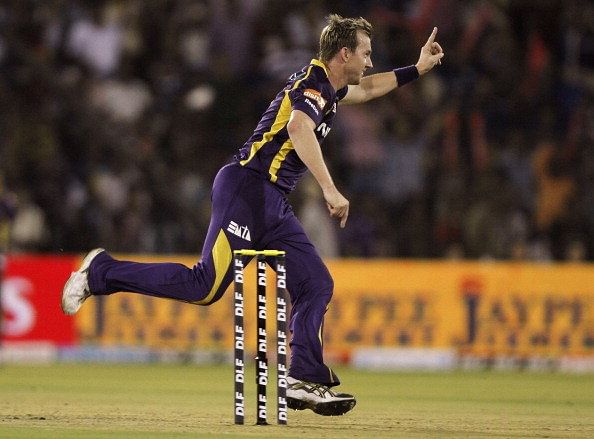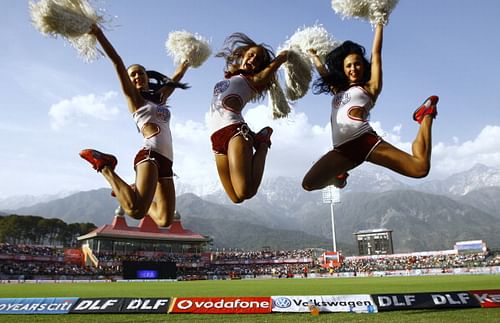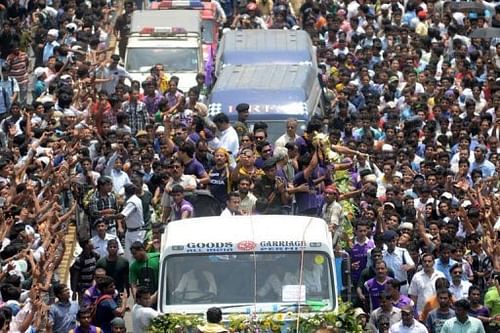
IPL 6: two sides to the coin
Yes, it is that time of year again and the IPL has returned for its sixth season, bringing along with it, the jazz, the insanity and everything but pure cricket. The opening ceremony was an unmitigated disaster, but the first ball of the sixth edition of this cricket carnival showed just how ruthless and merciless the IPL can make an Indian cricket fan.
Brett Lee charged in with grim determination and broke 20-year-old Unmukt Chand’s stumps. The capacity crowd at the Eden Gardens rose as one and cheered the dismissal of one of their tender and developing own while laying murmured praise on a seasoned foreign veteran.

However, the second ball of the match showed just how wonderful the IPL can be as Mahela Jayawardene walked to the middle, took his guard, stood his ground as a determined Brett Lee charged in, watched the ball pitch short, adjusted quickly and guided the ball over the slip cordon for a boundary. Truly, a lovely passage of play.
Rewind to the moments following Unmukt Chand’s wicket. The very second the young Indian’s stumps were knocked over, the broadcast shifted to the Kolkata Knight Riders‘ cheerleaders who began their monotonous dance. Lee’s unplayable delivery was forgotten within seconds as the cheerleaders stole the limelight. Five seconds of ridiculous dancing later, much to the disappointment of the thousands of Indian men glued to their TV sets, the commercial break began. Cheesy Lays chips, Havells fans and Pepsi advertisements took centre-stage, denying Lee even a single replay.
Every true cricket fan enjoys watching and analyzing every aspect of every delivery; the bowler’s run-up, the batsman’s movement, the seam position of the ball, etc. To add insult to injury, the broadcast of the match returned just as Lee was at the end of his run-up, thereby ensuring that we – the true cricket fans – lost another one of our little pleasures.

Advertisements play a huge role in generating revenue for the broadcast provider, but at what cost? ‘Cost’ here can be taken in two ways. (A) The precious few seconds that every cricket lover loses by watching Gautam Gambhir ‘join a new team for Rs. 5′ instead of watching an Australian veteran charge towards a Sri Lankan legend, ball in hand. (B) The ridiculous prices Sony Max charges to air these very advertisements. For example, the price tag of a three second advertisement during the finals of IPL 5 was Rs. 1 lakh.
Undoubtedly, the IPL does provide some spectacular entertainment and a few life-changing opportunities; Chand facing Lee with David Warner at the non-striker’s end is truly diverse and a sight that is unique to the IPL. The last-ball finishes, Ravi Shastri’s overuse of the word ‘electrifying’, a certain West Indian’s ‘Gayle storm’ and those nerve-wrecking moments during a super-over are some of the reasons why the IPL has dominated TV viewership.
Any ‘caring’ Indian uncle or aunt will tell you, “Paise sabse zaroori hai” (“Money is of utmost importance”), and this attitude prevails across the IPL with Bollywood celebrities and ridiculously rich businessmen thrown into the mix of the already money-hungry cricketers. Massive amounts of money are spent on the auctioning of players, after-parties and of course, hiring the cheerleaders. This situation begs the question: what if even a fraction of this money was spent on developing other sports like football or hockey?
In 2007, a young Indian cricket team led by the charismatic Mahendra Singh Dhoni made headlines and stole the spotlight as the Indian team won the inaugural T20 World Cup. The young champions of the team soon became household names and national heroes. They were awarded huge sums of money by the Central Government as well as the State governments.
As these youths raked in their money and smiled through their glory, another band of Indian youths watched in disappointment as their achievement of winning hockey’s Asia Cup was over-shadowed by the ever-domineering cricketers. The Central and State governments, who so gladly went all out in an effort to financially reward the cricketers, failed to even give the hockey players a simple pat on the back. Hockey players were once again given the cold shoulder by the government three years later, as they beat the likes of Australia and South Africa in an all-out effort which saw them proudly lift the Sultan Azlan Shah Cup in Malaysia.
Politics has also played a major role in the degradation in the quality of cricket. As the Kolkata Knight Riders won the fifth edition of the Indian Premier League, Mamata Banerjee spared no expense in rewarding ‘her’ players. After a dismal year in office during which she had not been able to usher in the promised changes, she personally scripted the felicitation function in an all-out effort to camouflage the state’s bankruptcy and poverty, making the KKR victory appear an outcome of her charismatic influence.
The IPL champions were felicitated by the Mamata-led state government at the 67,000-capacity Eden Gardens. The entry was made free by the government and, according to an unofficial count, about 1 lakh people turned up to witness the event. But 30,000 people were stuck outside and the situation turned ugly, prompting the police to carry out a lathicharge. The 25 gold chains and medals given by Mamata to the players left Bengal poorer by around Rs. 30 lakh.

“Bengal is proud. The victory of KKR is like a victory of the world.”
- Mamata Banerjee, after the felicitation ceremony.
Another instance of politics adversely affecting the IPL is that of all Sri Lankan cricketers being banned from playing Chennai matches after Tamil Nadu Chief Minister Jayalalithaa refused to host them in retaliation against the anti-Sinhalese sentiments that prevail across the state.
“In view of the popular antipathy and anger in Tamil Nadu against the actions of the Government of Sri Lanka, the Government of Tamil Nadu is of the view that IPL matches involving Sri Lankan players, umpires and other officials should not be played in Tamil Nadu.”
- Jayalalithaa, Tamil Nadu Chief Minister.
More recently, the BCCI was advised against allowing matches at the Wankhede stadium and the DY Patil stadium in Maharashtra as the state is facing one of its worst droughts ever. More than 60,000 litres of water are required by each stadium on a match day; the pitch consumes more water than entire villages. The BCCI’s decision to ignore this plea is yet another example of how greed can over-shadow humanity.
The IPL has always been a great source of entertainment, but at what cost? Is the transition from the ‘DLF Maximum’ to the ‘Yes Bank Maximum’ a change for the better, or for the worse? Only time will tell. In the meanwhile, every drop of water saved in Maharashtra has to be treated like a ‘Karbon Kamaal catch’.